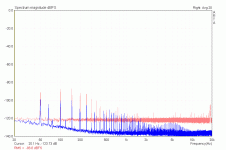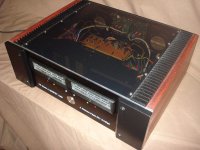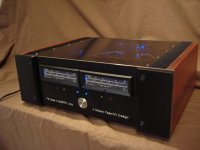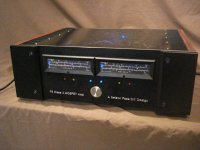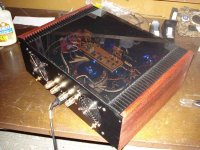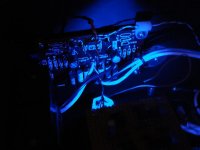Thanks for the compliments - I'm pleased to hear that 🙂.
Yes, some more colors would surely be helpful, but currently I've only got 20 gauge in black and yellow. I was looking for some heavier gauge at work but only found green-yellow-striped and, well, black...
I tested the amp this morning and was very (VERY) satisfied with the results. Everything went as expected, nothing went up in smoke and the shrinking tubes on the transistor leads shrinked themselves after a couple of minutes 😀.
First thing I measured was power supply ripple. On the big caps I have 90mV peak-peak and after the coils only 10mVpp left - 3,5mVrms, quite nice! On the output was nothing left, neither on the 'scope nor in the speakers. I'll hook it up to a soundcard to look at the spectrum this evening. That way I'll be able to adjust for lowest THD too, since it is not possible anymore to measure anything on the PCB - that's the drawback of my compact design 😱.
Here are two things which really surprised me: First off, there is absolutely no turn-on thump, in fact it's more like a soft-start of 500ms or so. And second, the caps are powerful enough to keep the machine up for a whole second! Quite like a tube amp 🙄.
The circuit is the simple Zen Redux, with a bit of feedback and, obviously, the C-L-C supply. I had it running for about an hour, the heatsink was getting quite warm but not really hot with the fan running at 10V. Maybe I'll settle for something like 8V fixed to keep it simple and quiet. Will have to test that while listening to the sound of this neat little hand-dryer 😉.
Yes, some more colors would surely be helpful, but currently I've only got 20 gauge in black and yellow. I was looking for some heavier gauge at work but only found green-yellow-striped and, well, black...
I tested the amp this morning and was very (VERY) satisfied with the results. Everything went as expected, nothing went up in smoke and the shrinking tubes on the transistor leads shrinked themselves after a couple of minutes 😀.
First thing I measured was power supply ripple. On the big caps I have 90mV peak-peak and after the coils only 10mVpp left - 3,5mVrms, quite nice! On the output was nothing left, neither on the 'scope nor in the speakers. I'll hook it up to a soundcard to look at the spectrum this evening. That way I'll be able to adjust for lowest THD too, since it is not possible anymore to measure anything on the PCB - that's the drawback of my compact design 😱.
Here are two things which really surprised me: First off, there is absolutely no turn-on thump, in fact it's more like a soft-start of 500ms or so. And second, the caps are powerful enough to keep the machine up for a whole second! Quite like a tube amp 🙄.
The circuit is the simple Zen Redux, with a bit of feedback and, obviously, the C-L-C supply. I had it running for about an hour, the heatsink was getting quite warm but not really hot with the fan running at 10V. Maybe I'll settle for something like 8V fixed to keep it simple and quiet. Will have to test that while listening to the sound of this neat little hand-dryer 😉.
I am trying to find the 'Zen Redux' , and not having any success. Is it published on PassDIY or is it a DIYaudio circuit?
Could you post a picture or link? Thanks!!!
Could you post a picture or link? Thanks!!!
I posted a quick video on youtube... with my bias readings...
YouTube - f5 amp
I've also got an initial sound demo (connected to my ipod & optimus speakers)
(ok, they're my computer desktop speakers 🙂 )
http://www.youtube.com/watch?v=VW7MWNZsZUs
(this is private if you want to see this, send me an IM with your youtube id, or email address)
Looks great. Congratulations and double congrats on the wonderful readings you are getting.
Which box are you using?
I am trying to find the 'Zen Redux' , and not having any success. Is it published on PassDIY or is it a DIYaudio circuit?
Uuh, where did I got that Redux from? Can't remember... Actually it is called Zen Amplifier Revisited or Return Of Zen, here's the link: http://passdiy.com/pdf/retofzen.pdf.
Sorry for that inconvenience 😱.
I'm not able to do any testing today anymore, since I blew the fuses. Didn't check what types were in that salvaged mains filter, but had to discover it was 1A fast blow, not exactly what's needed here 🙄. Obviously the variac helped them to survive this morning.
If it's interesting for anybody, here's a plot that ARTA gave me. The blue plot is from the Zen, the pale red one from a Pioneer SX-339, for comparison. The Pioneer's volume was set to equal that of the Zen, as it obviously has a bit more gain. Both amps were tested with the inputs connected to the soundcard and the output loaded with a real speaker.
As you can see, the Zen has even lower hum than a commercial Class-AB amp (well, it's not that high-endish, but still) and is a lot less noisy! I'm using Spendor S6 with 88dB efficiency, where I can hear the noise of the Pioneer with the ear directly in front of the speaker. The Zen is totally inaudible.
I'm quite happy with my scrapzen, although I have to admit that the air flow through the heatsink is a bit more noisy than I'd like it to be. Guess I'll put a thermocouple on it, close the case and see how hot it'll run with only minimal air flow.
Anyhow I found some use for my collected parts, learned a lot about Class A and have a nice heat radiator now for next winter, wich also plays some warm tunes if I like it to 😉.
As you can see, the Zen has even lower hum than a commercial Class-AB amp (well, it's not that high-endish, but still) and is a lot less noisy! I'm using Spendor S6 with 88dB efficiency, where I can hear the noise of the Pioneer with the ear directly in front of the speaker. The Zen is totally inaudible.
I'm quite happy with my scrapzen, although I have to admit that the air flow through the heatsink is a bit more noisy than I'd like it to be. Guess I'll put a thermocouple on it, close the case and see how hot it'll run with only minimal air flow.
Anyhow I found some use for my collected parts, learned a lot about Class A and have a nice heat radiator now for next winter, wich also plays some warm tunes if I like it to 😉.
Attachments
My F5
Finally got the front panel end plates powder coated, so here's the final project:
-- F5 two channel, common PSU
-- Speaker protection
-- Weston "projection" VU meters, modified for LED light sources
-- Heatsink temp sensors/alarms (currently set for 55 degrees C)
-- Clipping monitors
-- African hardwood side panels (to match my other equipment)
-- All chassis plates 3/16" aluminum; Conrad heatsinks
-- Plexiglass top cover with internal blue LED highlighting
-- Two low-speed AC muffin fans to circulate air to the heatsink fins
Construction details and more details are at this thread:
http://www.diyaudio.com/forums/pass...-build-beautiful-music-different-drummer.html
Heatsinks running cool, the fans are silent, and the amp sound great! Thank you, Papa Pass.....!!
Finally got the front panel end plates powder coated, so here's the final project:
-- F5 two channel, common PSU
-- Speaker protection
-- Weston "projection" VU meters, modified for LED light sources
-- Heatsink temp sensors/alarms (currently set for 55 degrees C)
-- Clipping monitors
-- African hardwood side panels (to match my other equipment)
-- All chassis plates 3/16" aluminum; Conrad heatsinks
-- Plexiglass top cover with internal blue LED highlighting
-- Two low-speed AC muffin fans to circulate air to the heatsink fins
Construction details and more details are at this thread:
http://www.diyaudio.com/forums/pass...-build-beautiful-music-different-drummer.html
Heatsinks running cool, the fans are silent, and the amp sound great! Thank you, Papa Pass.....!!
Attachments
What a clever way to use the "blue" light! 🙂
I think I first got the idea from a K-Mart store--at the "Blue Light Special" counter.....!
🙂 With all the blue lights in our computer fans, one would think all of us would have figured that one out... no such luck on my part.
Haven't been to K-mart in years, do remember the blue-light-special, though. Ha!!
Haven't been to K-mart in years, do remember the blue-light-special, though. Ha!!
Yeah, same here with K-Mart. Wal-Mart built a Superstore adjacent to a K-Mart here. The K-Mart parking lot is a ghost town; the Wal-Mart lot overflows on weekends. (And they say there aren't many "fun things to do" in Colorado Springs!)
While we're on the subject of blue LEDs, these two Weston VU meters are the only ones I've found in the last 45 years; they employ a light source (originally a 5W incandescent pilot bulb, but now a .5W blue LED) to project on the VU meter face, using the internal VU meter movement to deflect the beam. As a result, the VU reading is actually a "beam of light" from the LED that moves across the meter face.
While we're on the subject of blue LEDs, these two Weston VU meters are the only ones I've found in the last 45 years; they employ a light source (originally a 5W incandescent pilot bulb, but now a .5W blue LED) to project on the VU meter face, using the internal VU meter movement to deflect the beam. As a result, the VU reading is actually a "beam of light" from the LED that moves across the meter face.
the front panel end plates
Looks dandy, neo-classic retro kinda.
The heatsink tunneling is a cool cooling idea.
(tastes always differ though, the LED Xmas tree is a tad over the top imo, that front panel deserves All-Blue minimalism)
Last edited:
Jacco,
Yep....the old-school "retro look" with a simple Pass Class A internal was what I was shooting for. Thanks for picking up on that.
I probably have mixed emotions, too, on the LEDs. I figure I'll tire of the internal LEDs about the same time I get tired of polishing the plexiglass. When that happens, I'll probalby swap out the plexi for a powder-coated top cover.
Same goes for the clipping (yellow) and heatsink temp (red) LEDs. If I rarely get any "alarms", I'll probably clean up the front panel (and the vectorboard) and remove them.
Yep....the old-school "retro look" with a simple Pass Class A internal was what I was shooting for. Thanks for picking up on that.
I probably have mixed emotions, too, on the LEDs. I figure I'll tire of the internal LEDs about the same time I get tired of polishing the plexiglass. When that happens, I'll probalby swap out the plexi for a powder-coated top cover.
Same goes for the clipping (yellow) and heatsink temp (red) LEDs. If I rarely get any "alarms", I'll probably clean up the front panel (and the vectorboard) and remove them.
Very clever CAM. Really! I'll bet it's just beautiful in the dark.
Can't wait to fire it up, next to my lava lamp collection! (Kidding....just kidding!)
Just stick a simple low pass and hi pass filter and get the led to flash as the amp plays along.
You can also ang a litle triangle in front of them And play same Floyd
Diy time machine!
You can also ang a litle triangle in front of them And play same Floyd
Diy time machine!
Just stick a simple low pass and hi pass filter and get the led to flash as the amp plays along.
'Nothing like turning a high-end Class A amp, into a color organ, huh? 😀
- Home
- Amplifiers
- Pass Labs
- Pictures of your diy Pass amplifier
